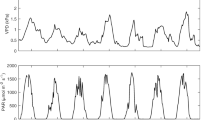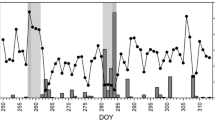Abstract
Key message
A high spatial resolution dataset of sap flux density in subtropical conifers is used to assess the minimum number and location of sap flow sensors required to monitor tree transpiration accurately.
Abstract
Tree transpiration is commonly estimated by methods based on in situ sap flux density (SFD) measurements, where the upscaling of SFD from point measurements to the individual tree has been identified as the main source of error. The literature indicates that the variation in SFD with radial position across a tree stem section can exhibit a wide range of patterns. Adequate capture of the SFD profile may require a large number of point measurements, which is likely to be prohibited. Thus, it is of value to develop protocols, which rationalize the number of point measurements, while retaining a satisfactory precision in the tree SFD estimates. This study investigates cross-sectional SFD variability within a tree and successively for six individual trees within a stand of Pinus elliottii var. elliottii × caribaea var. hondurensis (PEE × PCH). The stand is part of a plantation in subtropical coastal Australia. SFD is estimated using the Heat Field Deformation method simultaneously for four cardinal directions with measurements at six depths from the cambium. This yields a reference value of single tree SFD based on the twenty-four point measurements. Large variability of SFD is observed with measurement depth, cardinal direction and selected tree. We suggest that this is linked to the occurrence of successive narrow early and latewood rings with contrasting-specific hydraulic conductivities and wood water contents. Thus, an accurate placement of sensors within each ring is difficult to achieve in the field with the sensor footprint covering several rings of both early and latewood. Based on the reference dataset, we identified both an “ideal” setup and an “optimal” setup in terms of cost effectiveness and accuracy. Our study shows the need of using a systematic protocol to optimize the number of sensors to be used as a trade-off between precision and cost. It includes a preliminary assessment of the SFD variability at a high spatial resolution, and only then based on this, an appropriate placement of sensors for the long-term monitoring.



Similar content being viewed by others
References
Alvarado-Barrientos M, Hernandez-Santana V, Asbjornsen H (2013) Variability of the radial profile of sap velocity in Pinus patula from contrasting stands within the seasonal cloud forest zone of Veracruz, Mexico. Agric For Meteorol 168:108–119
Anfodillo T, Sigalotti G, Tomasi M, Semenzato P, Valentini R (1993) Applications of a thermal imaging technique in the study of the ascent of sap in woody species. Plant Cell Environ 16:997–1001
Brauman KA, Daily GC, Duarte TKE, Mooney HA (2007) The nature and value of ecosystem services: an overview highlighting hydrologic services. Annu Rev Environ Resour 32:67–98
Brown A, Podger G, Davidson A, Dowling T, Zhang L (2007) Predicting the impact of plantation forestry on water users at local and regional scales. An example for the Murrumbidgee River Basin. For Ecol Manag 251:82–93
Bubb KA, Croton JT (2002) Effects on catchment water balance from the management of Pinus plantations on the coastal lowlands of south-east Queensland, Australia. Hydrol Process 16:105–117
Cannell MG (1999) Environmental impacts of forest monocultures: water use, acidification, wildlife conservation, and carbon storage. New Forest 17(1–3):239–262
Caylor KK, Dragoni D (2009) Decoupling structural and environmental determinants of sap velocity: Part I methodological development. Agric For Meteorol 149:559–569
Čermák J, Cienciala E, Kučera J, Hällgren JE (1992) Radial velocity profiles of water flow in trunks of Norway spruce and oak and the response of spruce to severing. Tree Physiol 10(4):367–380
Cermak J, Kucera J, Nadezhdina N (2004) Sap flow measurements with some thermodynamic methods, flow integration within trees and scaling up from sample trees to entire forest stands. Trees 18:529–546
Cermak J, Nadezhdina N, Meiresonne L, Ceulemans R (2008) Scots pine root distribution derived from radial sap flow patterns in stems of large leaning trees. Plant Soil 305:61–75
Clearwater MJ, Meinzer FC, Andrade JL, Goldstein G, Holbrook NM (1999) Potential errors in measurement of nonuniform sap flow using heat dissipation probes. Tree Physiol 19(10):681–687
Cohen Y, Cohen S, Cantuarias-Aviles T, Schiller G (2008) Variations in the radial gradient of sap velocity in trunks of forest and fruit trees. Plant Soil 305:49–59
Cox ME, Preda M, Brooke B, (2000) General features of the geosetting of the pumicestone region. Passcon 2000—Pumicetone passage and deception bay catchment conference, 9–15
Davis TW, Kuo C-M, Liang X, Yu P-S (2012) Sap flow sensors: construction, quality control and comparison. Sensors. doi:10.3390/s120100954
Delzon S, Sartore M, Granier M, Loustau D (2004) Radial Profiles of sap flow with increasing tree size in maritime pine. Tree Physiol 24:1285–1296
Domec JC, Gartner BL (2002) How do water transport and water storage differs in coniferous earlywood and latewood? J Exp Bot 53:2369–2379
Downes G, Drew D (2008) Climate and growth influences on wood formation and utilisation. South For J For Sci 70(2):155–167
Dragoni D, Caylor KK, Schmid HP (2009) Decoupling structural and environmental determinants of sap velocity Part II observational application. Agric For Meteorol 149:570–581
Dye PJ, Olbrich BW, Poulter AG (1991) The influence of growth rings in Pinus Patula on heat pulse velocity and sap flow measurement. J Exp Bot 42:867–870
Fiora A, Cescatti A (2006) Diurnal and seasonal variability in radial distribution of sap flux density: implications for estimating stand transpiration. Tree Physiol 27:1217–1225
Fiora A, Cescatti A (2008) Vertical foliage distribution determinates the radial pattern of sap flux density in Picea abies. Tree Physiol 28:1317–1323
Ford C, Goranson C, Mitchell R, Rodney E, Teskey R (2004a) Diurnal and seasonal variability in the radial distribution of sap flow: predicting total stem flow in Pinus taeda trees. Tree Physiol 24:951–960
Ford C, McGuire M, Mitchell R, Teskey R (2004b) Assessing variation in the radial profile of sap flux density in Pinus species and its effect on daily water use. Tree Physiol 24:241–249
Gebauer T, Horna V, Leuschner C (2008) Variability in radial sap flux density patterns and sapwood area among seven co-occurring broad-leaved tree species. Tree Physiol 28:1821–1830
Guyot A, Ostergaard KT, Lenkopane M, Fan J, Lockington DA (2013) Using electrical resistivity tomography to differentiate sapwood from heartwood: application to conifers. Tree Physiol 33:187–194
Hatton TJ, Catchpole EA, Vertessy RA (1990) Integration of sapflow velocity to estimate plant water use. Tree Physiol 6:201–209
Irvine J, Law BE, Kurpius MR, Anthoni PM, Moore D, Schwarz PA (2004) Age-related changes in ecosystem structure and function and effects on water and carbon exchange in ponderosa pine. Tree Physiol 24(7):753–763
Jimenez MS, Nadezhdina N, Cermak J, Domingo M (2000) Radial variation in sap flow in five laurel forest tree species in Tenerife, Canary Islands. Tree Physiol 20:1149–1156
Kennedy RW (1995) Coniferous wood quality in the future: concerns and strategies. Wood Sci Technol 29(5):321–338
Koestner B, Biron P, Siegwolf R, Granier A (1996) Estimates of water vapour flux and canopy conductance of scots pine at the tree level utilising different xylem sap flow methods. Theoret Appl Climatol 53:105–113
Koestner B, Granier A, Cermak J (1998) Sap flow measurements in forest stands: methods and uncertainties. Ann Sci For 55:13–27
Lewis A (1992) Measuring the hydraulic diameter of a pore or conduit. Am J Bot 79:1158–1161
Mark W, Crews D (1973) Heat-pulse velocity and bordered pit condition in living Engelmann Spruce and Lodgepole pine trees. For Sci 19:291–296
Nadezhdina N, Cermak J, Nadezhdin V (1998) Heat field deformation method for sap flow measurements. 4th international workshop on measuring sap flow in intact plants. IUFRO, Zidlochovice, 1998
Nadezhdina N, Cermak J, Ceulemans R (2002) Radial patterns of sap flow in woody stems of dominant and understory species: scaling errors associated with positioning of sensors. Tree Physiol 22:907–918
Nadezhdina N, Vandegehuchte MW, Steppe K (2012) Sap flux density measurements based on the heat field deformation method. Trees—structure and function 0931–1890:1–10
Oishi AC, Oren R, Stoy PC (2008) Estimating components of forest evapotranspiration: a footprint approach for scaling sap flux measurements. Agric For Meteorol 148:1719–1732
Phillips N, Oren R, Zimmermann R (1996) Radial patterns of xylem sap flow in non-, diffuse-, and ring- porous tree species. Plant Cell Environ 19:983–990
Prior L, Brodribb T, Tng D, Bowman M (2012) From desert to rainforest, sapwood width is similar in the widespread conifer Callitris columellaris. Trees. doi:10.1007/s00468-012-0779-3
Saveyn A, Steppe K, Lemeur R (2008) Spatial variability of xylem sap flow in mature beech (Fagus Sylvatica) and its diurnal dynamics in relation to microclimate. Botany 86:1440–1448
Shinohara Y, Tsuruta K, Ogura A, Noto F, Komatsu H, Otsuki K, Maruyama T (2013) Azimuthal and radial variations in sap flux density and effects on stand-scale transpiration estimates in a Japanese cedar forest. Tree Physiol 33:550–558
Steppe K (2004). Diurnal dynamics of water flow through trees: design and validation of a mathematical flow and storage model. Doctoral dissertation, Ghent University
Steppe K, De Pauw DJW, Doody TM, Teskey RO (2010) A comparison of sap flux density using thermal dissipation, heat pulse velocity and heat field deformation methods. Agric For Meteorol 150:1046–1056
Vanclay KJ (2009) Managing water use from forest plantations. For Ecol Manage 257:385–389
Vandegehuchte MW, Steppe K (2012) Interpreting the heat field deformation method: erroneous use of thermal diffusivity and improved correlation between temperature ratio and sap flux density. Agric For Meteorol 162–163:91–97
Vandegehuchte MW, Steppe K (2013) Sap-flux density measurement methods: working principles and applicability. Funct Plant Biol 40(10):1088
Wilson KB, Hanson PJ, Mulholland PJ, Baldocchi DD, Wullschleger SD (2001) A comparison of methods for determining forest evapotranspiration and its components: sap-flow, soil water budget, eddy covariance and catchment water balance. Agric For Meteorol 106(2):153–168
Wullschleger SD, Meinzer F, Vertessy RA (1998) A review of whole-plant water use studies in tree. Tree Physiol 18:499–512
Zhang L, Zhao F, Chen Y, Dixon RNM (2011) Estimating effects of plantation expansion and climate variability on streamflow for catchments in Australia. Water Resour Res 47:W12539
Author contribution statement
A.G. did the analysis and the interpretation of the data. A.G. wrote the paper. A.G., K.O., J.F. and D.L. designed the study. A.G, K.O. and J.F. performed the measurements and processed the data. N.S. performed the microscopic analyses of the xylem.
Acknowledgments
The authors would like to thank Alexis Gertz, Mothei Lenkopane, Amy White, Yanzi Xiao and Chenming Zhang for their help during the fieldwork, in particular for the harvesting day. The authors would also like to thank ICT International for their feedback about the instruments. We acknowledge the insightful suggestions from the associate editors and the three anonymous reviewers. The National Centre for Groundwater Research and Training is a co-funded Centre of Excellence of the Australian Research Council and the National Water Commission. Forestry Plantation Queensland supported the work by allowing access to instrument the site and graciously offering the trees.
Conflicts of interest
The authors declare that they have no conflicts of interest.
Author information
Authors and Affiliations
Corresponding author
Additional information
Communicated by A. Franco.
Rights and permissions
About this article
Cite this article
Guyot, A., Ostergaard, K.T., Fan, J. et al. Xylem hydraulic properties in subtropical coniferous trees influence radial patterns of sap flow: implications for whole tree transpiration estimates using sap flow sensors. Trees 29, 961–972 (2015). https://doi.org/10.1007/s00468-014-1144-5
Received:
Revised:
Accepted:
Published:
Issue Date:
DOI: https://doi.org/10.1007/s00468-014-1144-5




